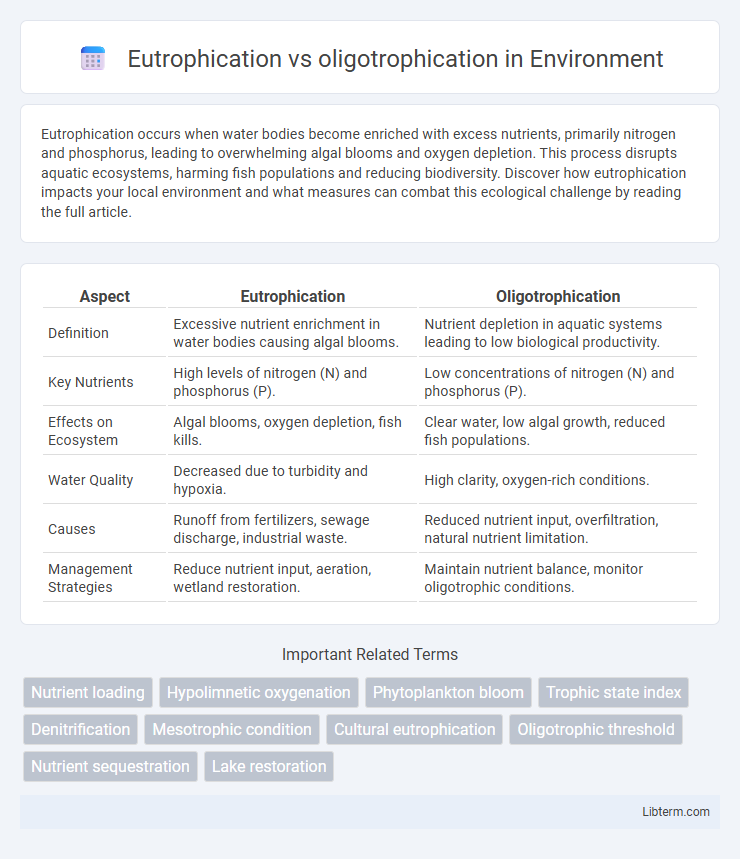Eutrophication occurs when water bodies become enriched with excess nutrients, primarily nitrogen and phosphorus, leading to overwhelming algal blooms and oxygen depletion. This process disrupts aquatic ecosystems, harming fish populations and reducing biodiversity. Discover how eutrophication impacts your local environment and what measures can combat this ecological challenge by reading the full article.
Table of Comparison
| Aspect | Eutrophication | Oligotrophication |
|---|---|---|
| Definition | Excessive nutrient enrichment in water bodies causing algal blooms. | Nutrient depletion in aquatic systems leading to low biological productivity. |
| Key Nutrients | High levels of nitrogen (N) and phosphorus (P). | Low concentrations of nitrogen (N) and phosphorus (P). |
| Effects on Ecosystem | Algal blooms, oxygen depletion, fish kills. | Clear water, low algal growth, reduced fish populations. |
| Water Quality | Decreased due to turbidity and hypoxia. | High clarity, oxygen-rich conditions. |
| Causes | Runoff from fertilizers, sewage discharge, industrial waste. | Reduced nutrient input, overfiltration, natural nutrient limitation. |
| Management Strategies | Reduce nutrient input, aeration, wetland restoration. | Maintain nutrient balance, monitor oligotrophic conditions. |
Introduction to Eutrophication and Oligotrophication
Eutrophication is a process where water bodies become enriched with nutrients, primarily nitrogen and phosphorus, leading to excessive growth of algae and aquatic plants. Oligotrophication occurs when nutrient levels decline, resulting in reduced biological productivity and clearer water with lower algal biomass. Understanding the balance between eutrophication and oligotrophication is essential for managing aquatic ecosystems and maintaining water quality.
Defining Eutrophication: Causes and Consequences
Eutrophication is the process of nutrient enrichment in aquatic ecosystems, primarily caused by excessive inputs of nitrogen and phosphorus from agricultural runoff, wastewater discharge, and industrial effluents, leading to dense algal blooms. These blooms deplete oxygen levels in the water, resulting in hypoxia or anoxia that severely impacts aquatic life and biodiversity. In contrast, oligotrophication involves nutrient depletion, often due to restoration efforts or reduced nutrient loading, promoting clearer waters and increased oxygen availability that support diverse and healthy aquatic communities.
Understanding Oligotrophication: Key Characteristics
Oligotrophication refers to the process where water bodies become depleted in nutrients, particularly nitrogen and phosphorus, leading to reduced primary productivity and clearer water conditions. Key characteristics include low concentrations of nutrients, high oxygen levels, and low algal biomass, often supporting diverse and stable aquatic ecosystems. This condition contrasts with eutrophication, which involves nutrient enrichment and excessive algal growth, causing oxygen depletion and ecological imbalance.
Major Drivers of Eutrophication in Aquatic Systems
Eutrophication in aquatic systems is primarily driven by excess nutrient inputs, particularly nitrogen and phosphorus from agricultural runoff, wastewater discharge, and industrial effluents. These nutrients promote excessive algal blooms that deplete oxygen levels, severely impacting aquatic biodiversity and water quality. Physical factors such as reduced water flow and temperature increases can exacerbate nutrient accumulation, intensifying eutrophic conditions.
Natural and Anthropogenic Factors in Oligotrophication
Oligotrophication occurs when nutrient levels, particularly nitrogen and phosphorus, decrease significantly in aquatic ecosystems due to both natural processes such as increased water flow and sedimentation, and anthropogenic influences including reduced agricultural runoff and improved wastewater treatment. Natural factors like prolonged droughts and climate-driven shifts in water chemistry can also limit nutrient availability, leading to decreased primary productivity. Human interventions targeting pollution control and land-use changes further accelerate oligotrophication by minimizing external nutrient inputs, contrasting the nutrient enrichment seen in eutrophication.
Ecological Impacts: Eutrophication vs. Oligotrophication
Eutrophication leads to excessive nutrient enrichment in aquatic ecosystems, causing algal blooms, hypoxia, and loss of biodiversity due to oxygen depletion. Oligotrophication results from nutrient depletion, reducing primary productivity and altering food web dynamics, often leading to clearer waters but diminished biological diversity. Both processes disrupt ecological balance, impacting species composition, water quality, and ecosystem services.
Case Studies: Eutrophic and Oligotrophic Water Bodies
Eutrophic water bodies such as Lake Victoria exhibit high nutrient levels, leading to excessive algal blooms and oxygen depletion, severely impacting aquatic biodiversity and fisheries. In contrast, oligotrophic lakes like Lake Tahoe maintain low nutrient concentrations, supporting clear waters and stable ecosystems with high oxygen levels favorable for cold-water fish species. Case studies reveal that nutrient management and human intervention are crucial for restoring equilibrium in both eutrophic and oligotrophic aquatic environments.
Management Strategies for Eutrophicated Waters
Management strategies for eutrophicated waters emphasize nutrient load reduction, primarily targeting phosphorus and nitrogen inputs from agricultural runoff, wastewater discharge, and industrial effluents. Techniques such as constructed wetlands, aeration, and biomanipulation help restore ecological balance by promoting oxygenation and controlling algal blooms. Continuous monitoring and adaptive management plans are crucial for sustaining water quality and preventing hypoxic conditions in affected aquatic ecosystems.
Restoration Approaches for Oligotrophic Systems
Restoration approaches for oligotrophic systems emphasize nutrient limitation management by minimizing external nutrient inputs, particularly phosphorus and nitrogen, to preserve water clarity and support native biota. Techniques include aeration to improve oxygen levels, biomanipulation to adjust food web dynamics, and wetland restoration for natural nutrient filtration. Monitoring nutrient cycles and employing adaptive management are crucial to maintain the system's low productivity and ecological balance.
Future Perspectives: Balancing Nutrient Levels in Aquatic Ecosystems
Future perspectives on balancing nutrient levels in aquatic ecosystems emphasize advanced monitoring technologies and targeted management practices to mitigate eutrophication while preventing oligotrophication. Integrating remote sensing data with nutrient cycling models enables precise regulation of nitrogen and phosphorus inputs, maintaining optimal ecological conditions that support biodiversity and water quality. Innovative restoration strategies, such as bioaugmentation and controlled nutrient release, promise sustainable solutions for preserving the resilience of lakes and coastal waters under changing climatic and anthropogenic pressures.
Eutrophication Infographic

 libterm.com
libterm.com